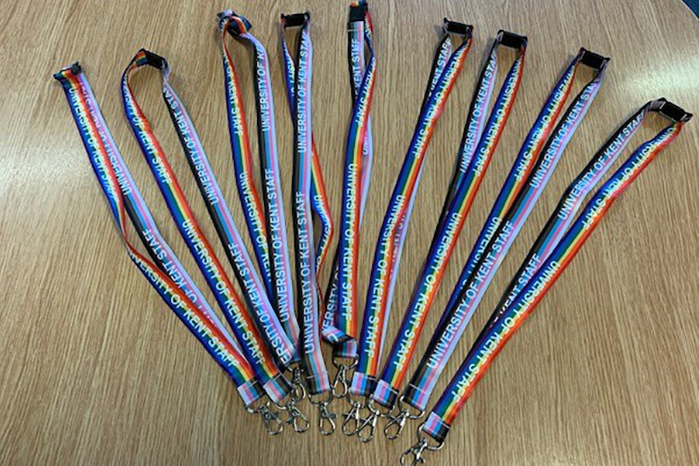Rainbow Lanyard
Our new Kent Rainbow Lanyard celebrates and promotes our work around Equality, Diversity and Inclusion. Wearing one shows your commitment to providing a safe and comfortable environment for all of our LGBTQ+ students and staff. It also shows LGBTQ+ people that they can ‘bring their whole selves’ to you without fear of judgement or an unsupportive reaction.
Designed by our LGBTQ+ Staff Network, and based on the Inclusion Flag, the Kent Rainbow Lanyard is a symbol that you are aware of the hardships marginalised members of the community have faced and continue to face, and that you are committed to supporting our LGBTQ+ staff and students by being a friend, advocate and a safe space, otherwise known as an Ally.
We know that being an Ally is not always easy, and like any skill it takes practice, awareness and education, which is why we have developed resource pages to help support anyone who wants to enhance their Allyship knowledge and skills. We would encourage anyone wearing a lanyard to explore these resources and self-educate to ensure that they feel confident in their allyship abilities.
Wearing a lanyard and displaying symbols of Pride at our sites is an important way to remind our LGBTQ+ staff and students that they belong here in our community, and should always feel safe, supported, and able to bring their whole selves to work and study with us.
There are three different types of Rainbow Lanyard available – one for staff, one for students, and one for Student Ambassadors. The lanyards are available in most outlets and reception desks across our Canterbury and Medway campuses.
Sunflower Lanyard
The Hidden Disabilities Sunflower is a globally recognised symbol for non-visible disabilities, also known as hidden disabilities or invisible disabilities.
Not all disabilities are visible – some are not immediately obvious. They include autism and learning difficulties as well as mental health conditions, mobility, speech impairments, and sensory loss such as speech, sight loss, hearing loss, or deafness. They also include respiratory conditions as well as chronic conditions such as diabetes, chronic pain, and sleep disorders when these significantly impact day-to-day life. Although you may not be able to see these invisible impairments and conditions, they’re still there.
People living with these often face barriers in their daily lives including a lack of understanding and negative attitudes. So some choose to wear the Hidden Disabilities Sunflower to discreetly identify that they may need support, help, or just a little more time in shops, transport, or public spaces.
You can collect your Sunflower Lanyard from Student Support and Wellbeing Services in Canterbury or Medway.
